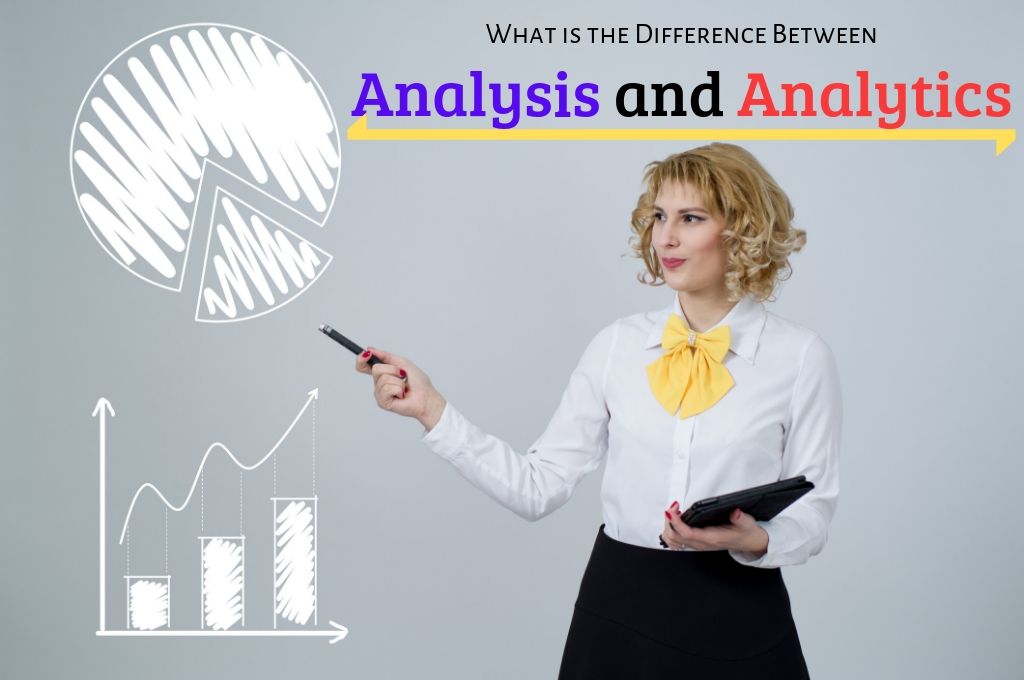Data Analysis and Data Analytics are two terms often used interchangeably.
Now, Why is this so?
Is this because they sound similar?
However, you should bear in mind that the supposed similarities between the terms are only phonetic similarities.
These two terms are quite dissimilar and they function both dependent and independent of each other. It is important to engage with the difference between the two terms as a lack of understanding can lead to indiscrepancies in the collection of data.
What is Analysis?
The Merriam-Webster dictionary defines analysis as ‘a detailed examination of anything complex in order to understand its nature or to determine its essential features: a thorough study’.
What is Analytics?
On returning to the Merriam-Webster dictionary we see that analytics is defined as ‘of or relating to analysis or analytics; especially: separating something into component parts or constituent elements’.
So, now that we have arrived at workable definitions for both terms, this immediately begs the question, how is both these terms related. Read further to find out.
Relation between Analysis and Analytics:
One simple method of deducing the difference between analysis and analytics is to place them in terms of the past and the future.
Data Analysis can be conceived of in terms of the past. Data Analysis in any field, whether in marketing, business, archiving etc looks at the past for its data collection.
This method of data collection is a way to unearth useful information which might have been overlooked.
The discovery of certain ‘tendencies’ or ‘patterns’ that Data Analysis attempts to locate through data collection helps in future decision making, better planning, conclusive research and inference.
So you might be asking how Analytics features in this.
Analytics works with the data that has been provided through Data Analysis. It basically, analyses data and statistics systematically.
Analytics is an umbrella term for analysis. Analysis is a part of the larger whole that is analytics.
Data Analytics draw conclusions from the ‘tendencies’ and ‘patterns’ that Data Analysis has located. The future decision making, conclusive research and inference is reached through Data Analytics.
Data Analytics is only possible if Data Analysis has been done and the process of Analysis can only be done by Analytics. Let us now take a look into how each of these processes work.
What is the Process of Data Analysis?
Data Analysis is a very precise and calculated process and is usually done by data scientists.
The entire process of Data Analysis is done through a step by step process. This process of production of data through this process is called the data value chain.
Data scientists work tirelessly as newer data arrives and research and inferences are constantly rewritten.
The data value chain is also used to predict better future outcomes. However, we should remember that as soon as the data is used to predict future outcomes, it has moved into the realm of Data Analytics.
So, let us see how the Data Analysis process works
Fixing an Objective:
The first step to Data Analysis is figuring out an objective. It usually helps if you ask yourself the following questions
1. What is the objective of this data collection?
2. What decisions are you attempting to arrive at through this data collection?
These questions have to be asked even before one embarks on the process of data collection. It is also important to remember that this data collection will be driving a decision making process.
However, one has to take into account the older model they are taking off from so one can trace the trajectory of the process. This brings us to the relationship between older models and the potential newer models that will be put in place after this entire process.
Identify the trajectory:
As discussed in the earlier point, one has to take into account and document the older model. This is an important step because it the only way of ensuring that the new model is an improvement.
This documentation also makes certain that the data collected is not meaningless. This process serves as a precedent for the next step which is collection of data.
Collection of Data:
Look for diversity while collecting data. Diversity of data helps one arrive at more wholesome conclusions.
It offers competing perspectives which in turn offers better insights and correlations. Always remember that the quality of data collection will reflect in the final outcome.
Cleaning Data:
Cleaning data is as important as the collection of data if not less. This is an important step to ensure the separation of meaningless data from meaningful data.
This also contributes to the correct reading of data as meaningless data can severely affect and mislead the result. This also separates the inaccurate data from the accurate data.
Also remember that prevention is better than cure, so if one has cleaned their data, chances of inaccuracies lessen.
Modelling of Data:
This is the part where the application of the collected data comes in. There are models built based off of the data that has been collected. These models provide a simulation of the actual outcome.
This is an important step and future steps are predicted based off these models. An accurate modelling of data is dependent on the data scientists building it, so one has to ensure that one’s data science team is efficient.
Verify your data:
This is an important step. One needs to verify their data repeatedly and ensure that there are no mistakes.
The model constructed from the collection of data will be put to practice after the modelling step. Any changes that are introduced into this process should be now.
Once the model has been put into practice the results will be recorded. The value of data generated will be accurate if the process of Data Analysis has been followed correctly.
Once the data has been generated, it will be used to monitor and record the trajectory of the analysis.
So this is an overview into how the process of Data Analysis unfolds. We will now move on to how Data Analytics work. We will also be looking into how and where they are similar or differ from Data Analysis.
Who Works on Data Analytics?
As specified earlier, the data scientist works on Data Analysis.
Data Analytics is more the area of specialization of data engineers. Data engineers work closely with data scientists to reach their common objective.
Data scientists gather data whereas data engineers connect the data pulled from different sources. Data engineers structure data and ensure that the model meets the analytic requirements.
However, it is important to remember that despite working on Analysis and Analytics, the work of the data engineer and scientist is interconnected. They both need the others assistance in various processes.
How does Data Analytics work?
Data Analytics is an incredibly complicated process. It makes inferences and draws conclusions through specialized software and systems.
Data Analytics can be further divided into quantitative Data Analysis and Qualitative Data Analysis.
So what is the difference between quantitative and qualitative Data Analysis
Quantitative Data Analysis involves analysis of quantifiable data. This kind of analysis relies more on statistics and empirical conclusions.
However, qualitative Data Analysis places more stress on the interpretation of nonquantifiable data such as audio visuals, subjective point of views etc. The application part of Data Analytic is dependent on BI.
So, what is BI?
BI or Business Intelligence is essentially a tool that allows users to draw data despite not having a background in statistical data. This relieves a lot of the stress placed on IT or data scientists to draw up reports.
BI allows end users to draw their own reports based on the data presented to them. The IT sector’s contribution is only required to set up the BI, they set up the data warehouse and data marts, users can access BI easily and draw up their own personalized reports.
This brings us to Data Mining, an integral part of Data Analytics.
What is Data Mining?
Data Mining is an advanced form of Data Analytics. It focuses on the modelling of data and sorts through enormous amounts of data and predicts outcomes based on patterns and repetitions.
Using this predictive analytics, it predicts future behaviour of target bases. There are numerous software, artificial intelligence, similar to the BI that assists in the sifting through data bases.
Machine Learning is one of these AIs. This saves a lot of resources and time as the above mentioned AIs sift through data faster than a data scientist.
However, it is to be noted that the data that these return is often not fully structured. This is where Text Mining becomes relevant.
What is Text Mining?
Text Mining also referred to as text data mining is a process that picks through unstructured and semi structured data to derive meaning.
The process of Text Mining starts with structuring the data. After this, through the step of statistical pattern learning, Text Mining, evaluates and interprets the now structured data.
So, let us take a look into
How the Process of Data Analytics work:
Collection of Data:
The first step of Data Analytics is the collection of data. Data scientists determine in this step what their analytic objective is and proceed accordingly.
Once the information required has been identified, data scientists work in tandem with engineers and the IT people to collect data. The data required is often sourced from different places.
The data collected is combined with other data through a complex integration process. Following this, the data is fed to the database.
However, if there is data that has been identified as ‘problem data’ and is in need of more analysis, it is separated from the data stream to analyse. This separation also ensures that the larger data set remains unaffected.
Data Fixing:
Once the data has been connected and analysed, the ‘problem data’ is examined. Any ‘problem data’ is paid a lot of attention because if it is not fixed at this initial stage, it can impact the final reading.
So, how is the ‘problem data’ identified and then fixed? This is done through three processes
- Data Profiling
- Data Cleansing
- Data Preparation
Data Profiling is self explanatory. It profiles the data at hand and ensures the information received is consistent with the larger data set. Data that shows any indisprecancies is removed at this stage.
The process of elimination of this data that has been recorded repeatedly shows no structural similarity or to the larger data set is done by Data Cleansing.
Data Preparation follows Data Cleansing. The data that has been collected after the process of elimination is then organized. It is done in a way such that it will prove favourable to the analytic purpose.
There are policies in places such as the Data Governance Policy that ensures that the saved data is not misused for any unethical purposes.
Modelling of Data:
The data scientist builds a model which serves as a predictive modelling tool for the data. This analytical model is tested against a part of the data set to check the outcome.
The model is tested repeatedly to ensure that it is fulfilling the objectives of Data Analytics. The process of the repeated testing of the model is known as Training.
The repeated testing also ensures that the model is functioning as retired. The end step involves running the model against the whole data set. This can only be done when it has been confirmed that the model is fulfilling the objectives of Data Analytics.
Data Visualization:
This is the last step of the Data Analytics process. This is the process through which the Analytics team communicates with the target audience.
They create charts, graphs, models and tables to communicate their findings better to their target audience.
This makes the entire reading accessible to the audience as they can better understand the quantitative data and look up numbers as they desire.








































